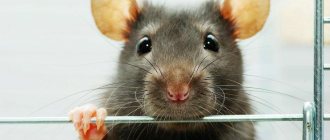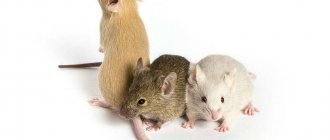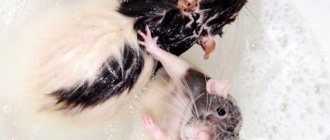The rat is considered one of the most intelligent and cunning species of rodents. And if you are now wincing with disgust and hostility towards this animal, then, most likely, you thought about the inhabitants of garbage dumps and basements, who are capable of carrying a myriad of diseases and infections. Another thing is decorative rodents, which can become an excellent friend for a pet lover in small apartments.
About who rats are, how they behave, what diseases domestic rats have, how to properly care for them, whether it is possible to wash decorative rats and much more - in our article.
Rat as a pet
Whatever animal you choose as a pet, you should remember the responsibility to the animal: it will have to be looked after, fed and loved, regardless of size, activity and type.
Often, future owners of four-legged animals mistakenly believe that if the animal is large, then there is a lot of trouble with it, and if it is small, then it does not require time. But in reality it's not like that. And often a tiny decorative rat requires more care than a huge guard dog. Therefore, if you are not ready to take on a number of responsibilities for caring for an animal, think about whether you want this responsibility or should you wait.
Training and playing with your pet
The variety of types of games with a rat will surprise you
Decorative rats have a natural intelligence, which makes them easy to train . It has been noticed that individuals with colored fur are more capable of learning. White rats are more inert. In addition, their eyesight is worse.
Rules for training decorative rats:
- The last meal should be 10–12 hours before the start of classes. In this case, the pet will be more active in seeking the treat.
- The maximum lesson duration is 30 minutes.
- Before starting training, the animal is given the opportunity to sniff and explore the place where the lesson will take place. In this case, the rat will not be distracted by unknown odors.
- Training is carried out starting with the reinforcement of random movements and actions. If the pet jumps over any object, reward it with a treat and return it to its original position.
- They complicate the task only after the previous actions have been fully practiced and consolidated.
Tricks that decorative rats can perform:
- jump over an object;
- jumping through a hoop;
- searching for treats in the maze;
- walking on hind legs;
- taking a piece of paper out of the box;
- choosing a specific item from several located next to each other;
- running up stairs (including rope stairs).
Playing together brings pleasure to both the owner and his pet. Most popular toys:
- small balls (ideally from table tennis);
- beautiful pieces of paper;
- matchboxes filled with treats.
Watching your pet play is interesting and educational. The game reveals the character of the rat, and the owner begins to better understand his pet.
Breeds of domestic rats
Today there are 137 species of domestic rats, as well as 570 subspecies . And each of them is interesting in its own way. The most common:
- breed of decorative rat - standard,
- tailless rats,
- rexes and double rexes,
- satin types,
- hairless,
- decorative dumbo rats,
- downy
At the same time, the color of decorative rats can be uniform, ticked (with a pattern) or combined. White domestic rats, gray domestic rats, and black decorative rats are often found. Less often - with hearts, spots and stripes.
Rats - popular Lariskas
Looking at photos of decorative rats, you understand that there is no single standard for determining the “breed”.
The ranking of the most popular of these decorative rodents includes:
- standard - large, smooth-haired animals with a tail equal to the size of the body. Reach up to half a kilogram of weight;
- satin - differ from their counterparts in soft long fur with a good shine;
- Dambo - round large ears and a sharp muzzle, a pear-shaped not very long body and an elongated tail;
- Sphynx - hairless individuals, may be born with age spots, but as adults the skin becomes pink;
- tailless - appeared in 1983 as a result of an unplanned mutation. Their body is shaped like a pear.
Keeping a rat at home
If you have no doubts about your decision to have a rat as a pet, be sure to find out all the features of keeping this type of rodent in your home.
For example, a rat has a very direct relationship with rodents - therefore, walking around the apartment, it will find something to chew on: from shoe laces to equipment wires. In this regard, the animal is either not allowed to go on such walks unattended, or all dangerous or valuable objects are removed in advance.
The second feature of the rat is its smell, which indicates the mark of the territory of residence. Ask yourself, are you ready for fragrant surprises?
Thirdly, rats are afraid of drafts and direct sunlight - you need to remember this when placing your pet’s cage (i.e., a window sill is definitely not a suitable place).
Please note that the comfortable air temperature for a rat is 18-21 °C (despite the fact that the body temperature of a decorative rat is higher than a human one - 38.3-39.3 degrees).
Cell selection
The best home for such a rodent is a large and spacious cage (not a jar, not a container or a box). You can buy it at any pet store - complete with ladders, house, feeder and drinking bowl or separately from them. Some owners make accessories for their pets with their own hands (let us just remember that plywood and cardboard are chewed off quite quickly, and the item will have to be replaced). Of course, the animal will really like and will not get bored with such elements as hanging shelves, a running wheel, swings, and branches that can be climbed. This will be especially appreciated by young individuals, but the “oldies” do not need so much entertainment when decorating the interior of the cage.
When choosing filler for the cage, give preference to large sawdust (small particles of wood species can get into the animal’s eyes, nose or ears and cause an allergic reaction). If you use paper as a bedding, it should be clean, without paint, writing or typography.
Cotton wool is not suitable as a filler!
The cage must be cleaned at least once a week. Be sure to do a complete disinfection to eliminate the risk of infecting your rat with parasites, bacteria and microbes that may appear in a dirty cage.
Genetics
The lifespan of a house mouse is influenced not only by lifestyle, but also by genetic predisposition.
The fact is that in pet stores, rats live in mixed-sex packs , which does not happen in the wild. Animals living in crowds mate uncontrollably, after which they live in cramped conditions unsuitable for normal existence. It is very difficult to trace the genetics of such an animal, so it is impossible to say how long such a rat will live and what life awaits it.
A completely different situation arises when animals are bred by a breeder. Matings in such cases are planned, and partners are selected depending on temperament. Rat pups from peaceful, sociable parents are prepared for sale as pets. Such babies are brought up in a favorable environment, which prevents the pet from displaying aggression in the future.
Females in nurseries give birth to cubs no more than twice a year . Frequent pregnancies exhaust the animal, as a result of which it produces weak, non-viable litters.
In order for a pet to be healthy, please its owners and live a long life, it must be purchased only in special institutions.
You will learn how to make the life of a pet rat comfortable in this video.
What to feed your pet rat?
It is not enough to know about the care and maintenance of a pet rat: feeding is an equally important aspect, because the pet constantly needs clean and fresh water and food. For liquids, a drinking bowl is placed so that the water does not spill and the cage does not become dirty and damp. The water needs to be changed every day.
The food should include grains (oats, wheat, millet, barley), fruits (apples, bananas, peaches, apricots, persimmons), berries (grapes, strawberries, raspberries), vegetables, herbs (dandelion and plantain leaves), dried fruits , nuts (except almonds) and chicken bones (necessary for grinding teeth). You can give meat, but in small portions and no more than once a week.
The normal feeding frequency is 2 times a day for adults, 3-4 times for children and adolescents.
Additionally, owners purchase a mineral stone that can provide the animal with the necessary amount of calcium.
List of prohibited products:
- roast,
- salty,
- smoked,
- fatty,
- spicy,
- cold,
- sweet.
So candy, chocolate, sausage, bread, soy are not an option. Vegetables such as cabbage, turnips, radishes, radishes, beets, legumes and raw potatoes should not be given. All permitted vegetables and fruits must be ripe (not green, but not overripe). Do not offer your rat leaves from indoor plants or fruit trees.
A properly selected diet is the key to animal health. It’s easy to put together if you know what pet rats eat and what you should absolutely not give.
Nail trimming
Rats have sharp toenails; trim them every 1-2 months. Trimming the nails is not difficult, but the rat will likely object and try to escape. If necessary, use human nail clippers to trim the tip a little. Avoid the pink (quick) part that may be visible inside the nail; there are blood vessels and nerves here.
If you cut a blood vessel, apply a little cornstarch to the tip of your nail to stop the bleeding. At the same time as you check your nails, try to take a quick look at your teeth to make sure they are not overgrown. Provide rats with plenty of opportunities (using wooden blocks and toys) to chew; this will keep their teeth short and healthy.
Diseases of decorative rats
Rats, like many other decorative rodents, can be overtaken by a variety of diseases, some of which are dangerous for humans. The causes of illnesses can be parasites, bacteria, viruses, fungi.
The following diseases are common:
- ectromelia (also known as smallpox) is a virus that, when it falls into the animal’s body, multiplies on the skin and internal organs (in the chronic form, ulcers, swelling and spots appear on the skin, which ends in tissue necrosis and gangrene; in the acute stage, there may be no symptoms, but the rat will die within 24 hours);
- listeriosis is a bacterial infection that is also dangerous for humans (infection occurs through bedding, food and cage accessories); body temperature rises, coordination is impaired;
- salmonellosis is a bacterium manifested by apathy, diarrhea, intermittent breathing, and without treatment it turns into edema, paralysis and irreversible organ damage (treated with antibiotics - chloramphenicol, biseptol, sulfadimethoxine);
- pneumonia - damage to the respiratory system by pathogens coronavirus and Sendai virus, manifested by discharge from the nose and eyes, sneezing, difficulty breathing, redness of the eyes, swelling of the throat, apathy, weight loss (treated with a course of antibiotics, anti-inflammatory drugs, immunomodulators and vitamins);
- mycoplasmosis - a genital, respiratory or mixed infection, manifested by enlarged lymph nodes, nasal discharge, pneumonia (the genital form may be asymptomatic);
- coccidiosis - a disease of the intestines and liver with frequent digestive disorders, jaundice, exhaustion;
- scab and actinomycosis are a fungus that enters the rat’s body after flea or tick bites, as well as through contaminated food (symptoms are ulcers, grayish blisters, scabs on the skin, hair loss, abscesses on the mucous membranes in the mouth).
Many diseases can be avoided if you wash your hands after handling your pet, give proven food and keep the animal’s cage clean.
Now you know how to care for a rat at home. Following all the recommendations is not very troublesome, but your smart animal will definitely thank you with its attention and love.
General health problems
Rats can develop many of the same problems as cats, dogs, and even humans. Possible problems range from tumors to respiratory or digestive diseases and neurological problems. Although it is physically possible to perform surgery on a rat, few owners are willing to pay for it, so disease prevention is the best option. If possible, find an exotic veterinarian in your area (a veterinarian with experience treating unusual pets) and schedule an initial appointment to gather baseline health data. A checkup every six months is the best step towards preventing or treating the disease.
Bumblebee (ulcerative pododermatitis) is a painful condition in rats that causes ulcers on the soles of the animals' feet. If left untreated, it can be fatal. This condition usually develops when a small wound on the foot becomes infected with Staphylococcus aureus or E. coli.











